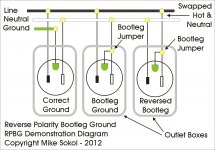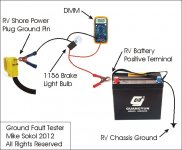Ys, even a perfect ground rod won't actually "ground" your RV. Those ground rods are really for lightning protection. As I've noted before, your RV's safety ground wire must be connected back to the Neutral/Ground/Earth bonding point at the electrical service panel to carry any significant fault current. As far as ground rod impedance, according to National Electrical Code a single ground rod that has less than 100 ohms impedance is all that's required. But if it exhibits MORE than 100 ohms impedance, a second ground rod is required.
Only "electronic" grounds for sensitive measuring equipment require a ground rod impedance of 25 ohms or less. Simple math shows you that 120 volts into a ground rod measuring 100 ohms only pulls 1.2 amperes from the line, certainly not enough to trip a 20 or 30 amp circuit breaker, but enough to trip any GFCI. Unfortunately, GFCI's are not required on any 30 amp RV pedestal outlets, but some 20 amp outlets will have a GFCI. However, many RV owners simply use a 30 to 20 amp adapter to get around the GFCI tripping issues, which are probably trying to save your life.
Ground loop fault impedance is another number, requiring no more than 1 ohm impedance back to the service panel. So math shows you that 120 volts across a 1 ohm load will attempt to draw 120 amps of current, certainly enough to trip any 20, 30, or 50 amp circuit breaker.


